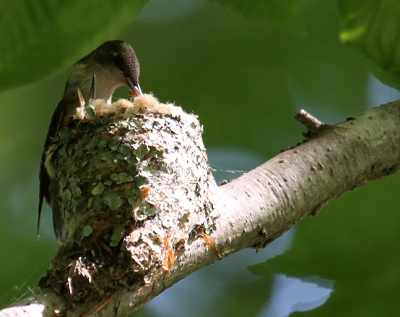(Archilochus colubris)
Description & Range:
Ruby-throated hummingbirds are iridescent green with white bellies. Their common name refers to the brilliant reddish-orange coloring on the throat of mature males during the breeding season. Females, in contrast, have a grayish throat with white underparts and green coloring on the upper body. Juveniles and non-breeding birds look similar to females. However, adult females have white outer corners on their tails while adult, non-breeding males do not.

Ruby-throated hummingbird male (left) by Joe Schneid and female (right) by Dick Daniels, Wikimedia Commons
In the summer, ruby-throated hummingbirds can be found throughout the eastern half of the United States and within parts of southern Canada. In the winter, ruby-throated hummingbirds travel to Mexico and Central America.
Habitat:
Ruby-throated hummingbirds can be found in open woodlands, forest edges, meadows, grasslands, and in suburban parks, gardens, and backyards.
Diet:
Ruby-throated hummingbirds are primarily nectar feeders, though they also will dine upon flying insects and caterpillars, particularly while nesting.
Female ruby-throated hummingbird enjoying bee-balm by Joe Schneid, Wikimedia Commons
Ruby-throated hummingbirds are naturally attracted to red and orange tubular-shaped flowers such as beebalm, cardinal flower, jewelweed, trumpet creeper, trumpet honeysuckle, and red buckeye. A list of plants that attract hummingbirds, butterflies and bees can be found on this page. In addition, they will visit nectar feeders. One part of white sugar can be mixed with 4 parts of water to make nectar. Boiling the sugar water and/or adding red dye are not necessary to attract hummingbirds. However, feeders should be kept clean and free of mold to prevent the spread of illness and disease. In addition, roaming felines can be very problematic for hummingbirds, and birds at a feeder are easy targets. Therefore, cats should be kept indoors and away from feeders. Because hummingbirds also rely on insects for part of their diet, pesticide use should be limited in and around backyards to ensure the safety of visiting hummingbirds.
Reproduction:

Female feeding chicks by Rick McArthur, Flickr CC
Ruby-throated hummingbirds migrate to Central America over the winter and then return to the eastern half of the United States in the spring. Some birds will continue as far north as Canada to breed. In Maryland, ruby-throated hummingbirds generally return in early April and begin breeding shortly after. Males will perform a courtship dance to woo the ladies. His dance includes making looping, U-shaped dives above the female.
After breeding, the male will leave the female to build the nest and raise the young. She will create a thimble-sized nest constructed of dandelion and thistle threads bound by spider webs and covered on the outside with moss and lichen. The spider silk allows the nest to expand as chicks grow while the moss and lichen provide camouflage. The female then will lay 2 eggs per clutch that take up to 2 weeks to incubate. The young will be born helpless and will take an additional 3-4 weeks to fledge.
Sounds:
At daybreak, males will sing a constant series of monotonous chips. Individuals will also commonly exchange an even chee-dit call, especially when chasing one another. Hummingbird wings will also make a quiet, humming noise as they zoom by.
Behavior:
Ruby-throated hummingbirds are expert flyers. They can easily adjust their position mid-air and can even fly backwards with precision. Male ruby-throated hummingbirds will aggressively defend food resources which often leads to chases and occasional jabs with the beak.
Did you Know?
- A ruby-throated hummingbird can beat its wings up to 53 times a second.
- The oldest known ruby-throated hummingbird was just over 9 years old!
- Ruby-throated hummingbirds have tiny feet which prevent them from walking or hopping on surfaces. Instead, they will shuffle to move on a perch.